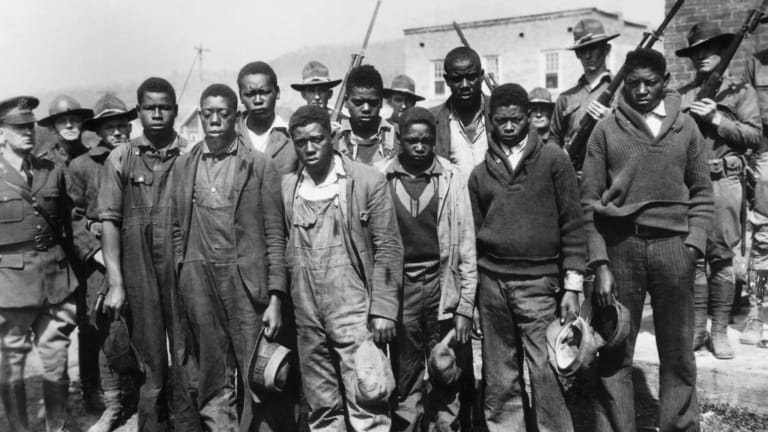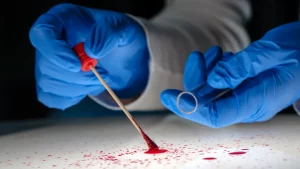April 7, 1931. Thousands of people gathered in the small town of Scottsboro, Alabama. A brass band entertained them with the song “There’ll be a Hot Time in the Old Town Tonight.”1 The verdict of nineteen-year-old Clarence Norris was read, convicting him of a crime he did not commit, and sentencing him to death. Clarence was the son of a former slave. At the young age of seven, he was put to work in the fields and went to school minimally. After his father died, he began working for wages, and he took a trip on the Southern Railroad to look for work. However, all it took was this train ride to change his whole life. And most importantly, all it took was this specific train ride to change history. Clarence Norris, an African-American teenager, was aboard that train, moving from town to town looking for a better life and a better opportunity. But what happened on that train ended all of those hopes. What began as a fight between a group of African-American teenagers and white teenagers would land Norris and the eight other “Scottsboro Boys” in jail with a minor charge. However, when two white females who were aboard the train told a different story, not only would the teenagers’ reputations be in danger, but their lives as well.
On the morning of March 25, 1931, nine African-American male teenagers were pulled off the train by the sheriff’s posse in response to a complaint about a fight on the train. Victoria Price, twenty-one, and Ruby Bates, eighteen, were also on the train hoboing, wandering aimlessly from one place to another looking for work. When questioned by the sheriff’s posse, the young ladies changed the lives of these nine young men when they accuse them of rape. By that evening, the local newspaper, Jackson County Sentinel, spread the word of this “revolting crime.”2
1931, ordinary general and department stores, houses, and schools were found on every corner. However, there was something far more sinister waiting around the corner. Groups of white individuals would gather together to form mobs to demand a lynching.3 This was what awaited the nine boys when they arrived at Scottsboro, only to be convicted of a crime they had not committed. By March 30, 1931, five days after being arrested for a minor charge, the Scottsboro Boys were all indicted by a grand jury. Then April 7 came. Distraught and alone, Clarence Norris found himself in a jail cell with a lynch mob forming outside the jail. The National Guard was brought in, in order to protect the Scottsboro Boys. Up to 10,000 spectators gathered as they brought Norris to trial, with armed soldiers on hand to keep the growing mob at bay. Bates had testified that she was beaten and bruised by the repeated rapes and that she lost consciousness, regaining consciousness only when she found herself on the way to the Scottsboro jail. However, multiple witnesses and officers reported seeing her fully conscious when she, and the boys, were taken off the train. R.R. Bridges, the physician who examined the two girls, testified that they showed evidence of recent sexual activity, but not recent enough to match the time of the alleged rapes, and they showed no evidence of bruising or violent treatment. The verdict was read and Clarence’s fate was in the hands of an all-white jury. The defense team provided to Clarence was Tennessee attorney Stephen R. Roddy, an alcoholic, who was not familiar with Alabama law, and Milo Moody, a 69-year-old lawyer who hadn’t practiced in years. 4 Despite the contrary evidence, in less than two hours, with the testimonies of Price and Bates, and the lack of proper representation, nineteen-year-old Clarence was sentenced to death. Surrounded by strangers, charged by men and a system built against his people, Clarence Norris began his forty-five-year long hardship, not only fighting for his rights, but also for his life.
“I was scared before, but it wasn’t nothing to how I felt now. I knew if a white woman accused a black man of rape, he was as good as dead… All I could think was that I was going to die for something I had not done.” – Clarence Norris 5

Anger and dismay began to sweep the nation and around the world over the racially motivated arrests and prosecution of the boys. In May of that year, hundreds of thousands of supporters gathered to protest the convictions and demanded the freedom of the young Scottsboro Boys.6 Astonished by the age of the defendants, the length of their trials, and sentences received, the National Association for the Advancement of Colored People (NAACP) as well as the International Labor Defense (ILD) reached out and provided support for the young men and their families. The organizations even raised money for appeals. However, the NAACP withdrew from the case due to the nature of the crime. 7

The following year, the Alabama Supreme Court kept all of the Scottsboro Boys convictions and death sentences except for the second youngest, Eugene Williams. In November, however, the U.S. Supreme Court ruled in Powell v. Alabama that Alabama had denied the defendants acceptable felony illustration or due manner guaranteed by the Fourteenth Amendment.8
During this time, Clarence spent the majority of his time on death row, haunted by the executions he could hear from his cell, and dreamt of his death. Norris was only nineteen years old and was forced to hear people being put to death. He lived knowing that the death penalty was the sentence handed to him, that eventually, his turn was going to come to be in that chair, for something that he never did. Norris was retried again in 1933, only to be sentenced to death yet again. However, this time his appeal was sent to the United States Supreme Court. In the trial, the court ruled that the absence of black jurors was a violation of the Fourteenth Amendment’s equal protection clause and called for a retrial.9 While awaiting a new trial, Norris felt alone and there was no one to talk to or anyone to listen to his story. Norris was tried and convicted a third time in 1937. Norris spent fifteen years in prison. Twice his head was shaved in preparation for his execution.
“I am alone, out to myself. No one to say a Kind word to Me just listens to the other people away from me.” – Clarence Norris
However, what the world didn’t expect was for the rape charges against Olen Montgomery, Willie Roberson, Eugene Williams, and Roy Wright to be dropped.10 As these Scottsboro Boys were released, Norris suspected that the State changed the story to get the four boys free, sacrificing his chance at freedom. The next year, his death sentence was commuted to life in prison. While working in a prison mill, Norris would lose a finger, be abused by guards, and spent long periods in solitary confinement. A once young man was now raised into the prison system, facing hardships for something he never did. Clarence Norris was losing hope.

In 1944 Clarence Norris stepped outside jail for the first time since 1931 when he was paroled.11 After prison, he was made to work in a sawmill by his parole officer. However, Norris had enough and it was time to leave, and he violated the conditions of his parole by leaving Alabama. At the time, Attorney Chalmers was still attempting to negotiate for the release of Powell and Patterson; his parole violations made this task monumentally more difficult. Eventually, Chalmers persuaded Norris to return to Alabama where he was taken into custody for another two years. Once paroled again, Norris violated his conditions by fleeing to New York, vowing to remain a fugitive, never to return.
Taking up his brother’s identity Norris found work on his own or with the help of friends like his defense lawyer, Samuel Leibowitz, and the NAACP. By the 1960s, he was living with a third wife and their children in Brooklyn, New York. Still, in violation of his parole, Norris always feared the effect of his past on his children. Norris contacted the NAACP to help him arrange a pardon. The NAACP launched a public campaign in the fall of 1976, which resulted in Governor George Wallace granting Norris a full pardon, officially freeing him at last, 45 years after his initial arrest.12 Norris died in 1989 at the age of 76, after publishing an autobiography, The Last of the Scottsboro Boys; he was the last surviving member of the original nine. It took eighty-two years for the State of Alabama to posthumously pardon the other Scottsboro Boys: Powell, Andy Wright, and Patterson in 2013.
Today, everyone who was a part of the trial is gone, but still, the story of the Scottsboro Boy lives on in sons, daughters, grandsons, and neighbors. The convictions of nine innocent teenagers have haunted the nation. It’s been 88 years since the Scottsboro Boys were first convicted of rape and sentenced to death, and most of the lives of the Scottsboro Boys have been lost in the light of this American tragedy. However, the effects of their cases have left an everlasting effect on today’s world and have helped provide the strength to bring justice in a time when people have become divided once more.13
“The lesson to black people, to my children, to everybody, is that you should always fight for your rights, even if it cost you your life. Stand up for your rights, even if it kills you. That’s all that life consists of.” – Clarence Norris
- Encyclopedia of Race and Racism, 2013, s.v. “Scottsboro Boys” by Margaret Burnham. ↵
- James Goodman, Stories of Scottsboro (New York: Pantheon Books, 1994), 11-12, Google Scholar. ↵
- James A. Miller, Susan D. Pennybacker, and Eve Rosenhaft, “Mother Ada Wright and the International Campaign to Free the Scottsboro Boys, 1931-1934,” The American Historical Review 106, no. 2 (2001): 390-391. ↵
- Hugh T. Murray, “The NAACP versus the Communist Party: The Scottsboro Rape Cases, 1931-1932,” Phylon (1960-), no. 3 (1967): 276-277. ↵
- James E. Goodman, Stories of Scottsboro (New York: Vintage Books, 1995), 5. ↵
- Hugh T. Murray, “The NAACP versus the Communist Party: The Scottsboro Rape Cases, 1931-1932,” Phylon (1960-), no. 3 (1967): 278. ↵
- James A. Miller, Susan D. Pennybacker, and Eve Rosenhaft, “Mother Ada Wright and the International Campaign to Free the Scottsboro Boys, 1931-1934,” The American Historical Review 106, no. 2 (2001): 390-391. ↵
- Encyclopedia of Race and Racism, 2013, s.v. “Scottsboro Boys,” by Margaret Burnham. ↵
- Norris v. Alabama, 294 U.S. 587 (1935). ↵
- Encyclopedia of the Supreme Court of the United States, 2008, s.v. “Scottsboro Boys” by William Bush. ↵
- James A. Miller, Susan D. Pennybacker, and Eve Rosenhaft, “Mother Ada Wright and the International Campaign to Free the Scottsboro Boys, 1931-1934,” The American Historical Review 106, no. 2 (2001): 392. ↵
- Encyclopedia of the Supreme Court of the United States, 2008, s.v. “Scottsboro Boys” by William Bush. ↵
- Encyclopedia of the Supreme Court of the United States, 2008, s.v. “Scottsboro Boys” by William Bush. ↵



75 comments
Melanie Fraire
I had never heard of this case prior to reading this article but I found it to be very interesting yet tragic. It’s very sad to see how many times a white woman’s word has gone against legitimate evidence all because the person “guilty” is someone of color. What happened to these boys was terrible and it’s sad that nothing can make up for having gone through this terrible experience.
Davis Nickle
What happened to Norris and the rest of the Scottsboro Boys was absolutely horrible. I can’t imagine what it must feel like to live live in prison for most of your life and having to worry that every day you might be executed for a crime you did not commit. It is a shame that this entire case happened and an even greater shame that Norris only got to live for a short time after his pardoning.
Lulu Avitua-Uviedo
In my non profit we fight for Human Rights, we fight against the grain for equality. At times it seems like a losing battle but at times we see the rewards. For someone to lose half their lives for a crime they did not commit are years never to return and that is so sad. On a flip side for someone who committed a crime and gets minimal time for “good behavior” is a part I can’t accept. The man who took my father’s life served only 7 years and was out for “good behavior”. Though times were different then, I lived my life without my Dad, he lived his life with his children. Where was justice then? For the sexual assault survivors who cannot speak up are usually living in fear within themselves and from the reaction they may receive from others. As a rape survivor, I spoke up, I followed through from beginning to end. I am a changed person because of my experience, that is why I fight for Justice to be served. Great article, it brought to surface what many may not have known.
Aracely Beltran
Another well written article bringing light to racism. Human rights are kind of a joke in certain eras, we are all supposed to have basic rights yet we see news like this. It is so sad that certain ethnicity’s from the beginning of time have felt superiority based off of something we can’t control. There are plenty of stories of how white people actually commit a crime much worse and get nothing as close as someone with different skin color would whom committed something such as having marijuana or even being innocent.
Maria Rivera
It has become increasingly common for sexual assault survivors not to come forward with an assault. Survivors often fear that they will not be believed if they come out with their truth. They also fear that their attacker(s) won’t face any penalties. Reporting the assault will subsequently make the survivor relive the traumatic experience with the possibility of an unfavorable outcome.
The fact that white women were so privileged, that law enforcement could disregard evidence that would exonerate Clarence Norris is just unfathomable. We need to work to improve our criminal justice system. There should never be an instance where an innocent man is incarcerated or put on death row.
Kacey Diaz
If I’m being honest. I don’t like reading stories like this but I know that what happened in the past will not be tolerated in the present. What happened with these boys and the accusations and sentencing was unfair and unjust to an extreme extent. What bothers me most about cases like this is that human rights are clearly being violated, yet people at the time didn’t care.
Kendall Guajardo
It is insane how corrupt and politically charged our justice system was and still is today. It is better to save one innocent man and let a hundred guilty ones go free. Our system is wired the opposite even today. All the state wants is someone convicted and for many cases rightfully so. However, as in this case, if we let our innate biases, political climate, and even constitutional violations seep into the system of supposed “justice.” then how can we ever proclaim that a democracy exists? This article was deeply sad and although they were pardoned in the end did it even matter at that point? Living a life of a false fugitive is not a life at all. What do we do when the justice system does the exact opposite of what its made to do. This is the deterioration of what our society deems as humanity in a first world country and how can we stop these continuous stories of injustice?
Shriji Lalji
This is a terrible incident, however it continues to happen. Race plays such big part when it comes to crimes and law enforcement. The system is quite unfair and unjust towards colored people. You would think that law enforcement would learn from their mistakes. However just look at the current case of Rodney Reed in Texas. The man was wrongfully sentenced to death for the rape of Stacey Stites. Although still a controversial case, new technological advances clearly show evidence to prove his innocence. Unfortunately he still remains in jail.
Ariana Melendez
It is infuriating that despite this case being disputed in the Supreme Court, justice was never served and what is worse is that it was due to Norris’ race. He had to become a fugitive in order to live out a life that should have never been taken away. The author does a great job of detailing the progress of Norris’ case as well as getting the readers to feel his pain. This was a major human rights violation that makes me question our processes and who we really protect under the law.
Savannah Alcazar
The introduction paragraph captured my attention and excited me for the rest of the article. I enjoyed the story-like quality of this piece. This article flowed well from event to event and kept my attention throughout. The kinds of things allowed due to racism are appalling. I cannot believe Norris had to spend his time on death row for something he did not do. I feel like our generation has taken strides toward equality for all people.